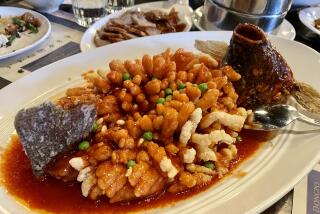How to Sail and Have Your Roast Goose Too
- Share via
Ocean liners are known for putting on a pretty good spread. This has to do with modern refrigeration and the growing prosperity, and therefore growing pickiness, of travelers, but a lot of it is simply a consequence of the steam engine. Back in the days of sailing ships (which were much smaller than modern liners to begin with), ocean travel was at the mercy of the winds, so most fresh foods were out of the question.
Travelers got around it as best they could. A ship of any size would include a sort of miniature barnyard--a couple of chickens and maybe a goose for their eggs, a goat for its milk, sometimes a cow or sheep--that could also mean fresh meat for special occasions. Connoisseurs could grow their own herbs in pots. But everything else had to be packed to keep indefinitely.
Old cookbooks often give advice on what the passenger should bring along on a sea voyage. Here are some typical tips for varying the basic diet of hardtack, beans and salt beef:
* Ham: Pack in charcoal to keep it from the rats and damp.
* Goose, sausages, veal: Cook and pack in a cask with enough melted butter or fat to cover by several inches. The butter or fat would eventually see use in the galley, of course.
* Tripe: Boil and barrel with vinegar. This vinegar would probably get used in cooking too, for good or ill.
* Fish: Salt a couple of hours, fry brown and barrel up with oil.
* Root vegetables and mushrooms: Dry in a slow oven. Mushroom powder would be useful for giving some semblance of flavor to gravies.
More to Read
Sign up for The Wild
We’ll help you find the best places to hike, bike and run, as well as the perfect silent spots for meditation and yoga.
You may occasionally receive promotional content from the Los Angeles Times.






